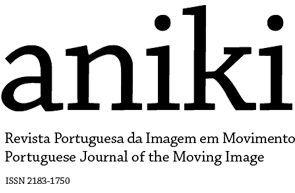Theories, practices and ontologies: the actor in the media
Film Studies have traditionally placed the figure of the actor (be it professional or amateur) at a relegate position, as a mere addition to the practical and symbolic construction of the film. This thematic section attempts at questioning this position, by placing the film actor at the centre of its own action: a site of expression, production of meaning, construction of visual and narrative forms, and possibly affective exchange. We intend to reflect about the actor’s figure ontology, considering new forms of examining their practice other than those valuing the mimetic nature of their work. We propose to establish relations between film and other media, using the human body as the centre to the construction of meaning.
Therefore, this issue will address the topic in two different ways. One is based in the acting studies tradition, following from the star studies cultural approach, which works from a stylistic perspective. This can include analysis of the relation of the film actor with elements such as mise-en-scène (photography, montage, framing, text), director, technique, character, as well as with the parafilmic elements (media discourses, publicity, parafilmic texts, etc.). Innovative approaches such as those of James Naremore (1988), Patrick McGilligan (1975), Luc Moullet (1993), Christian Viviani (2015) and Christophe Damour (2016) can be considered key to this thinking, which looks at the actor from two different angles: that of the body and that of the character. The first one contemplates the more concrete, material, and easily noticeable and measurable aspect to the actor’s craft; the second one comprises the more abstract side of the actor’s existence – their public image, constituted both by filmic and parafilmic elements.
The issue will also follow a second approach, grounded on the studies originating from the so-called "performative shift" (Fisher-Liche, 2008), which look at the actor’s work from a bodily, rather than textual, perspective, as a work capable of influencing the filmmaker’s aesthetic choices and the spectator’s reception of the film. This approach may be discussed in relation to a series of different schools and movements within film theory, as well as in relation to theatre studies in which that paradigmatic rupture originated or occurred (Brecht, Artaud, Grotowski, Brook, Schechner, Kirby, Beck and Malina, Auslander, Boal, Martinez Correa, among many others).
We propose to open a discussion that combines the mentioned performative shift with the various paths that the "realist turn" (Bazin, 1971) and the "parafictional" drifts (Ribas, 2016; Lambert-Beatty, 2009) took throughout the twentieth century and the first decades of the twenty-first. One of the most visible of those paths is the central role non-professional actors have been playing, and the debates around the unstable spaces arising between acting and non-acting, between the fictional character and the biographical dimension of the interpreter; between the actor’s own personality and the way the filmic text uses it.
Finally, this issue also intends to be a space for studies that follow filmic lineages different from those of more conventional or hegemonic models, bringing attention to less visible subjects in the context of film studies.
We invite proposals of papers directly or indirectly concerned with the following subthemes:
- Aesthetic analysis of an actor’s play or of a director’s conception of acting;
- The body’s placement on set and stage, considered from different angles: the interpreter’s experience; the multiple identities of the cinematographic subject and the construction of their character;
- Comparisons between theatrical performance and cinematic performance, considering the specificities of film acting;
- The actor’s position within a broader system of signs, namely those linked to human sciences (sociology, economics) and the arts (theatre, painting, photography) and communication;
- Analysis of the aesthetic and ethical potentialities of the parafictional territory, which may include articles focusing on documentary film and ethnographic influence;
- Differing topologies and cinematic subjects and the notion of film as a "key to the other's secret" (Rancière, 2009).
References
BAZIN, André (1971). “An Aesthetic of Reality: Cinematic Realism and the Italian School of the Liberation”, in What is cinema? (Vol. II). Berkeley/Los Angeles/London: University of California Press.
DAMOUR, Cristophe (2016). Montgomery Clift, le premier acteur moderne. Strasbourg: Accra/Presses Universitaires de Strasbourg.
FISCHER-LICHTE, Erika (2008). The Transformative Power of Performance: A New Aesthetics. London: Rutledge.
McGILLIGAN, Patrick (1975). Cagney, the Actor as Auteur. London: A.S Barnes, South Brunswick, Tantivity.
MOULLET, Luc (1993). Politique des acteurs. Paris: Editions de l’Etoile/Cahiers du Cinéma.
NAREMORE, James (1988). Acting in the cinema. Berkeley/Los Angeles/London: University of California Press.
RANCIÈRE, Jacques (2009). “Política de Pedro Costa”, in Cem mil cigarros: os filmes de Pedro Costa. Lisbon: Orfeu Negro.
RIBAS, João (2016). “Salomé Lamas: Parafictions”, in Parafictions. Milan: Mousse Publishing.
VIVIANI, Christian (2015). Le magique et le vrai, l’acteur de cinema, sujet et objet. Paris: Rouge Profond.
The deadline for submitting completed papers is December 15, 2018. All the articles submitted to Aniki will be the object of a double-blind peer review process. Before submitting your article, please read the journal’s Section Policies and the Authors’ Guidelines.
Guest Editors’ biographies
Pedro Guimarães is a lecturer at the Film Department and at the Post-Graduate Program in Media Studies at the Universidade Estadual de Campinas (Brazil). He co-ordinates GEAs (Grupo de Estudos sobre o Ator no Cinema), a study group devoted to the role of the actor in film (GEAs). Guimarães has published on this topic as well as Cinematic Genres and Film Theory.
Teresa Fradique is an Adjunct Professor at Escola de Artes e Design de Caldas da Rainha – IPLeiria (Portugal) and a researcher at the Centro em Rede de Investigação em Antropologia (CRIA - Centre for Research in Anthropology). She is currently part of the coordinating team of Núcleo de Antropologia Visual e Arte (Visual Anthropology and Arts Laboratory). Fradique has published and actively participated in the areas of performance and visual culture.




